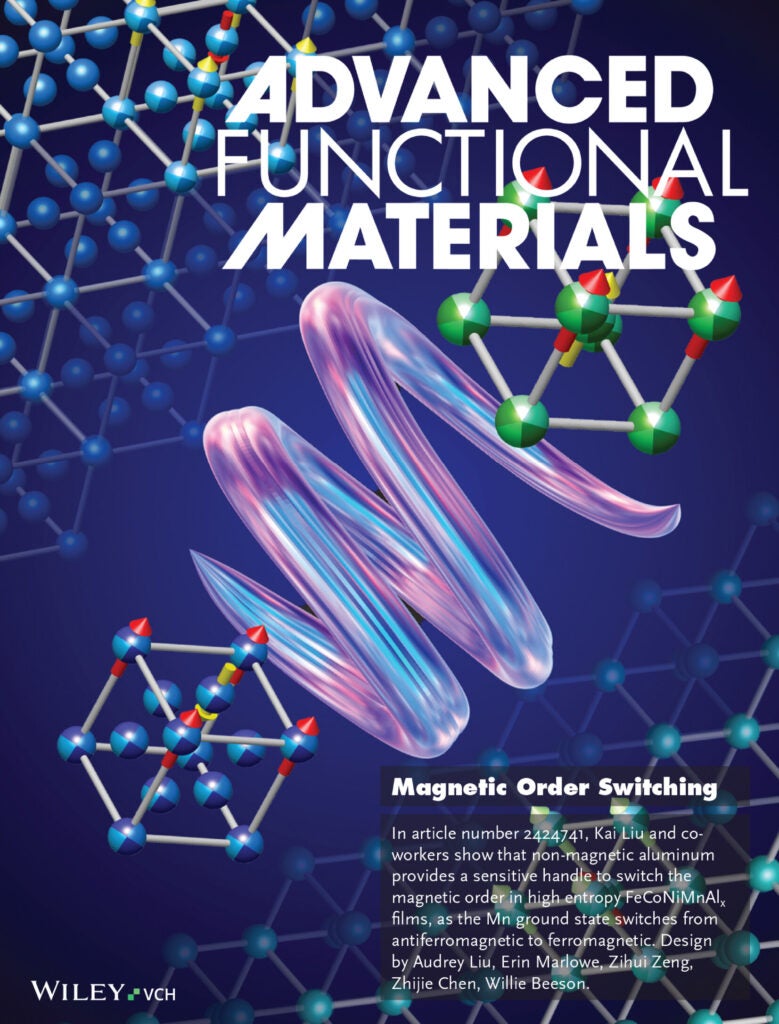Switching of Magnetic Order in High Entropy Alloys
Posted in News Story

A team of scientists led by graduate student Willie Beeson in Prof. Kai Liu’s group in the Physics Department of Georgetown University has demonstrated a new way to control magnetism in a special class of metals called high entropy alloys (HEAs). This finding could open up a new arena to explore novel magnetic phases hosted by the vast compositional space of HEAs, and lead to new technologies in areas like nanoelectronics and energy-efficient magnetic memory devices. Their results are just published in Advanced Functional Materials and featured in a Frontispiece.
High entropy alloys are made of multiple elements in nearly equal amounts, creating materials with sometimes unusual properties such as exceptional mechanical strength and chemical stability. In magnetic HEAs, the competition between different magnetic interactions can lead to complex and unconventional magnetic behaviors, offering exciting opportunities for research and innovation. Now, Beeson and coworkers have found that by adding just a small amount of nonmagnetic aluminum to a HEA made of iron, cobalt, nickel, and manganese, they can dramatically change its magnetic properties.
The team showed that these single layer thin films, just tens of nanometers in thickness, can behave like complex magnetic systems usually created by stacking multiple layers of materials. Surprisingly, a slight change in the amount of aluminum caused the material to switch its internal magnetic order and cubic crystal structure, making it more ferromagnetic—where all the atomic magnetic moments line up in the same direction.
Theoretical calculations performed by Dr. Dinesh Bista and Prof. Gen Yin at Georgetown University revealed that the key to this behavior lies in how manganese atoms inside the alloy respond to aluminum. With the right amount of aluminum, the manganese atoms switch their magnetic alignment from antiferromagnetic to ferromagnetic, allowing the material’s overall magnetic state to be widely tuned, while the alloy crystal structure changes from face-centered-cubic to body-centered-cubic. This is confirmed experimentally using X-ray magnetic circular dichroism (XMCD), carried out by Nushrat Naushin and Prof. Roopali Kukreja at the University of California, Davis, and Dr. Alpha T. N’Diaye at the Lawrence Berkeley National Laboratory (LBNL).

The ability to engineer such complex magnetic effects in a single, simple material could make it easier and more cost-effective to develop next-generation technologies.
“This shows that by making very small changes in composition near certain tipping points in the parameter space, we can design materials with completely different magnetic behaviors,” said Liu. “It opens up an exciting path for creating customizable materials for future electronics and magnetic devices.”
Notably, Beeson just recently defended his Ph.D. thesis “High Entropy Materials with Strong Magnetic Anisotropy” with distinction.
The study was supported in part by the National Science Foundation, and utilized the Pittsburgh Supercomputing Center through the Advanced Cyberinfrastructure Coordination Ecosystem: Services & Support (ACCESS) program, and the Advanced Light Source at LBNL that is supported by the Department of Energy Office of Science User Facility.

